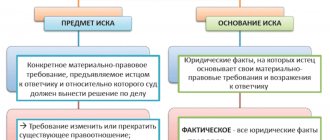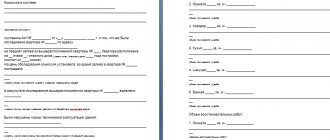Home / Real estate / Land
Back
Published: 11/16/2017
Reading time: 9 min
3
824
After choosing a suitable plot of land, you should not rush to purchase it. Initially, you need to check it for the presence of various encumbrances that could significantly limit its use.
- Definition and legislation
- Bases and methods of application
- Types of encumbrances
- How to find out encumbrances?
- Encumbrance agreement
- Removal of encumbrance
Types of restrictions on property rights
In current legislation, there are quite a few types of encumbrances that can limit the right to dispose of a particular living space. The main types include:
- Transfer of real estate to another person in the form of collateral (most often when applying for a mortgage or bank loan). This issue is regulated by Article 11 of the Law of the Russian Federation “On Mortgages”, as well as paragraph 3 of Chapter 23 of the Civil Code of the Russian Federation.
- Conclusion of an annuity agreement, including lifelong maintenance with dependents (Chapter 33 of the Civil Code of the Russian Federation).
- Drawing up a rental agreement, renting residential premises for a period of 1 year or more, concluding a free use agreement (Chapter 34-36 of the Civil Code of the Russian Federation).
- Seizure of property (Law of the Russian Federation “On Enforcement Proceedings”).
- Establishment of an easement on land (Chapter 4 of the Land Code of the Russian Federation).
- Transfer of a property into trust management (Chapter 53 of the Civil Code of the Russian Federation).
- Other types of encumbrances.
The legislative framework
The Land Code of the Russian Federation provides a complete concept and characteristics of encumbrance. It also describes the rights of plot owners under various types of restrictions. The following regulations regulate encumbrance issues:
- Articles 11.4 – 11.7 regulate the specifics of the formation of plots and the emergence of rights to them;
- Article 11.8 defines the legal powers of owners in the presence of an encumbrance;
- Federal Law No. 122 of July 21, 1997 describes the process of registering encumbrances on land.
In what cases should you go to court?
In most cases, the owner does not need to apply to a judicial authority to cancel the encumbrance. For example, a life annuity agreement terminates at the death of the annuitant. In this case, to remove the restriction on real estate, the other party only needs to submit a death certificate to Rosreestr.
If we are talking about renting residential premises, then the basis for releasing the apartment from the rights of guests will be an agreement that specifies the specific period of validity of such an encumbrance.
However, there are situations in which it will not be possible to cancel the imposed restriction without the consent of the other party. This mainly concerns property pledged to a banking institution when applying for a mortgage, loan, etc.
In this case, you will definitely need a mortgage from the bank with a note stating that the borrower has fully fulfilled his obligations. However, some unscrupulous creditors deliberately avoid issuing such a document.
Finding himself in such a situation, the client is forced to file a statement of claim with the court containing a demand for a court decision, according to which the plaintiff will be able to independently cancel the imposed encumbrance.
There may also be another situation where litigation may be required. We are talking about lifting the arrest from a property. The need to file a claim containing such a claim may arise in the following cases:
- the presence of rights to the seized housing on the part of other persons (if the bailiff described property that does not belong to the debtor by right of ownership);
- if such a restriction was imposed on an apartment that is also owned by the debtor’s spouse;
- The bailiff unreasonably refuses to remove the encumbrance from the seized living space, etc.
Procedure
The general algorithm of actions to remove restrictions from real estate in court will be as follows:
- First of all, the owner should send a pre-trial claim to the bank that does not want to issue a mortgage.
If we are talking about the seizure of real estate, then the addressee of such a letter will be a bailiff. Attention! It should be borne in mind that if the pre-trial procedure for resolving a dispute is not followed, the court may reject the received statement of claim. - If the request was ignored, then you can begin to prepare a claim and collect the necessary documents.
- Next, the complete package of papers should be sent to the territorial judicial authority.
- Wait for the court summons and take part in the hearings.
- After a positive court decision is made, you can contact Rosreestr and arrange everything yourself.
Preparation
Preparation for trial should begin with drawing up a statement of claim.
You can do this yourself (if you have certain skills and knowledge) or entrust it to a lawyer. The claim is prepared in writing. Moreover, its content must meet the requirements set out in paragraph 2 of Art. 131 Code of Civil Procedure of the Russian Federation. The following information must be included in the text:
- Name of the district judicial authority. In a particular case, this will be a court of general jurisdiction.
- Information about the plaintiff (full name, residential address).
- Information about the defendant. The name of the bank, the address at which it is located (in case of a mortgage) or the full name and position of the bailiff, the full name of his place of work (in case of seizure of housing).
- The essence of the violation committed by the other party.
- Evidence of the legitimacy of the claims being made.
- The cost of the claim (if the client wishes to additionally recover monetary compensation for moral damage).
- A note on compliance with pre-trial order.
- List of applications.
In addition to the statement of claim, an additional package of documents will also be required to force the removal of the encumbrance.
This should include (Article 132 of the Code of Civil Procedure of the Russian Federation):
- Receipt for payment of state duty.
- Power of attorney issued to an official representative.
- Documentary evidence of the legality of the claims included in the text of the claim. If we are talking about a mortgage, then this could be a mortgage agreement, a certificate from the bank about repayment of the entire amount of the debt, etc.
When seizing real estate, the following can be attached to the claim:
- documents confirming the fact that all debts have been repaid;
- marriage certificate (if the pledged property is the common property of the debtor and his wife), etc.;
- a copy of the pre-trial claim;
- calculation of the amount to be recovered from the defendant (if any).
In accordance with the procedure established at the legislative level, when going to court, the plaintiff must pay a state fee, the amount of which is indicated in Art.
333.19 Tax Code of the Russian Federation. Thus, when removing the encumbrance from seized property, an individual will need to pay 300 rubles, and a legal entity - 6,000 rubles (clause 3, clause 1, article 333.19 of the Tax Code of the Russian Federation).
If the subject of the claim is a demand for forced cancellation of the encumbrance imposed on the mortgaged apartment, then the applicant will be exempt from paying the state duty. The fact is that in this case he is a consumer of the service provided by the bank, and, therefore, is exempt from this type of payment (Clause 3 of Article 17 of the Law of the Russian Federation “On the Protection of Consumer Rights”).
Having prepared a complete package of necessary documents, a citizen, if desired, can send it to the judicial authority at his place of residence, at the address, location of the bank, in the territory where the mortgage agreement was concluded (in connection with which the real estate encumbrance arose) or to the district court, where The FSSP department is located (in case of seizure of real estate).
You can do this in the following ways:
- by personal visit to the court office;
- sending by registered mail.
Where should the assembled package be submitted?
Citizens can submit an application and all necessary documents to remove the encumbrance on their mortgaged property using 3 different options:
- The most reliable way is to contact the Federal Service for State Registration, Cadastre and Cartography (Rosreestr) directly. However, this option may not be convenient for many citizens due to the limited number of territorial branches of this body.
- The second popular option for submitting documents is to contact the Multifunctional Center. Currently, this method is the most relevant, since citizens can contact any nearest branch of the MFC to submit papers.
- The third way to submit an application is to use the Government Services portal.
When submitting an application through the State Services website, the borrower will still have to appear in person at the government agency to receive a new extract from the Unified State Register.
How to release your property after a court decision?
If a positive court decision is made, the plaintiff will be able to freely free his property from the rights of third parties. It's quite simple to do this:
- First, you need to take away the court decision that has entered into force.
- Prepare the appropriate application and collect the necessary documents (passport, court decision, etc.).
- Take the papers to Rosreestr. This can be done in person, through the MFC, or you can submit an application on the State Services website. In the case of seizure of real estate, all these procedures will have to be carried out by the body that imposed the seizure (bailiff). However, the owner, having an official court decision in hand, can do this independently.
- Wait for the procedure to complete.
For example, a registration entry on the repayment of a mortgage is repaid within 3 days from the moment the necessary documents are received by Rosreestr. Note! But the question of how long it takes to lift the arrest placed on an apartment cannot be answered unambiguously, since the exact deadlines are not specified in the law.
Thus, most often the need for legal proceedings arises when removing an encumbrance placed on a property in connection with the registration of a mortgage or when an apartment is seized.
In the first case, this is due to the fact that some banks deliberately delay the procedure for issuing a mortgage, as a result of which the client is forced to go to court. Speaking about the second situation, most often the owner files a claim in case of illegal actions of the bailiff who seized the property, as well as if there is a legal right to eliminate such a restriction.
How to correctly formulate claims?
Based on the above, in the main part of the statement of claim for the removal of the mortgage encumbrance through the court, it is necessary to include your own requirements for the defendant. First of all, you should demand that the encumbrance be terminated, taking into account the provisions of the law and the fulfilled obligations. Once again, indicate the coordinates and characteristics of the residential premises in question. You can then claim reimbursement for the costs spent on paying the state fee. The conclusion contains a list of attached documentation, the date of application and the signature of the plaintiff.
It will take up to thirty days for the application to be reviewed by the judicial authorities. Based on the results of the proceedings, the judge will make a decision, which will come into force after ten days. During this time, the defendant has the right to file an objection. After this, you can send a new application to Rosreestr, where you are required to remove the existing restrictions. A standard package of papers is provided along with the application. If the claim is drawn up without errors, the structure required by law is preserved, strong evidence is provided and all documents are attached, the chances of a positive court decision increase. Otherwise, the claim may be left without consideration or the appeal may be rejected.
Free initial consultation with a lawyer Let's look at your legal situation or question. We'll tell you what to do next. Call - it's free:
- For residents of Moscow and Moscow Region:
- Other regions of Russia:
Also write to us via online chat or form on the website.
As an advertisement








